 | | | Switch to: Europe, USA, New Zealand, Antarctica Credit: NOAA/Ovation  Planetary K-index Planetary K-index
Now: Kp= 1 quiet
24-hr max: Kp= 1 quiet
explanation | more data
Interplanetary Mag. Field
Btotal: 4.76 nT
Bz: 2.36 nT north
more data: ACE, DSCOVR
Updated: Today at 1147 UT  Coronal Holes: 05 Jul 22 Coronal Holes: 05 Jul 22 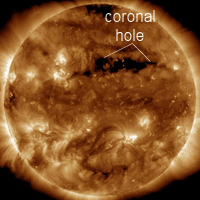
Solar wind flowing from this northern coronal hole should reach Earth on July 6-7. Credit: SDO/AIA  Noctilucent Clouds Noctilucent Clouds
Noctilucent cloud season is underway. The clouds are currently spreading as far south as +45N. Switch view: Europe, USA, Asia, Polar Updated Jul05  SPACE WEATHER
NOAA Forecasts | | Updated at: 2022 Jul 05 2200 UTC FLARE | 0-24 hr | 24-48 hr | CLASS M | 15 % | 15 % | CLASS X | 01 % | 01 % |  Geomagnetic Storms: Geomagnetic Storms:
Probabilities for significant disturbances in Earth's magnetic field are given for three activity levels: active, minor storm, severe storm Updated at: 2022 Jul 05 2200 UTC Mid-latitudes | 0-24 hr | 24-48 hr | ACTIVE | 40 % | 35 % | MINOR | 25 % | 15 % | SEVERE | 05 % | 01 % | High latitudes | 0-24 hr | 24-48 hr | ACTIVE | 10 % | 10 % | MINOR | 25 % | 25 % | SEVERE | 65 % | 50 % | | | |  | | | | | | | | | | | Never miss another geomagnetic storm. Sign up for Space Weather Alerts and you'll receive a text message when magnetic storms erupt. Aurora your guides and professional astronomers use this service. You can, too! | | | GEOMAGNETIC STORM WATCH: NOAA forecasters say there is a chance of minor G1-class geomagnetic storms on July 6th when a stream of solar wind is expected to hit Earth's magnetic field. The gaseous material is flowing from a cyclops-like hole in the sun's atmosphere. Aurora alerts: SMS Text. NEW SUNSPOT: A new sunspot is emerging over the sun's northeastern limb.Pepe Manteca of Barcelona, Spain, took a look and found a dark core big enough to swallow Earth: 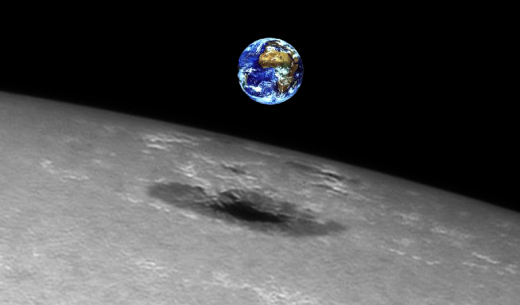
Provisionally numbered AR3053, the sunspot is crackling with almost-M-class solar flares. It will turn toward Earth in the days ahead, increasing the geoeffectiveness of its explosions. Aurora alerts: SMS Text. Realtime Space Weather Photo Gallery
Free: Spaceweather.com Newsletter AURORAS ON THE 4TH OF JULY: A CME that narrowly missed Earth on July 1st ignited a pair of geomagnetic storms with auroras during the long holiday weekend. Greg Ash photographed the light show during the early hours of July 4th from Ely, Minnesota: 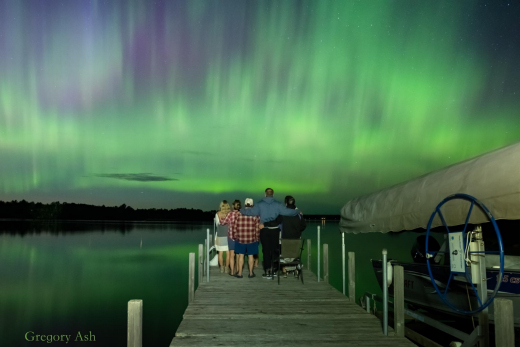
"It was a pleasure to watch three generations captivated by this beautiful pulsating colorful light show," says Ash. "The auroras were very visible to the naked eye." The CME that caused the display was probably launched from the sun on June 28th by an erupting filament of magnetism. It wasn't squarely on the sun-Earth line and didn't actually strike our planet. Instead, as it passed by, it shoved dense solar wind plasma toward Earth; think of the wake of a passing speed boat. Ripples from the near miss sparked G1-class geomagnetic storms on July 2nd and July 4th. "The twin storms not only produced beautiful auroras, but also they also moved magnetometer needles including my own here in the UK," reports Stuart Green who recorded the event: 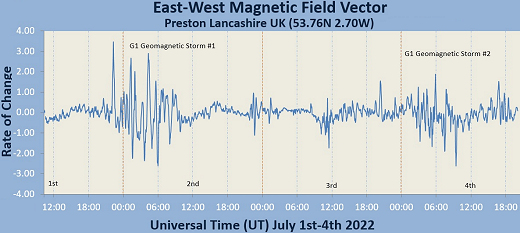
The squiggles in Green's chart represent changes in ground-level magnetic fields caused by the CME. "The sensor is buried in my garden about 0.5 meters below the surface in an East/West orientation," he explains. "This allows very sensitive (sub nanotesla) measurements of magnetic declination during geomagnetic storms." Green built his own magnetometer from scratch. Would you like to do the same? Here's how. more images: from Jake Stehli of Winona, Minnesota; from Rocky Raybell of Keller, Washington; from Marybeth Kiczenski of Ludington, Michigan; from George Dunham of Crawford, Colorado; from Dwight Brady of Marquette, MI; from Sarah Goodwin of Mears, MI; from Thomas Spence of Tofte, MN; from Michele Sadauskas of Glidden, WI; from Matthew D. Moffet of Billings, Montana; from Kalyky of Kinsey, Montana Realtime Aurora Photo Gallery
Free: Spaceweather.com Newsletter THE EDGE OF SPACE BUTTERFLY: Are you looking for a far-out gift? Consider the Edge of Space Butterfly. On June 26, 2022, this crystal pendant hitched a ride onboard an Earth to Sky Calculus cosmic ray research balloon:
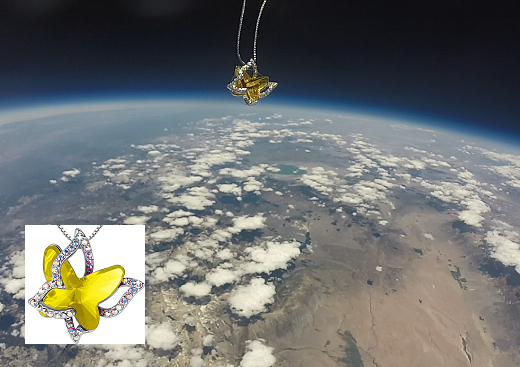
You can have it for $162.95. The inner yellow citrine crystal is surrounded by a "spread your wings" lattice of sparkling zirconia. A rich layer of rhodium plating ensures the longevity of the pendant and its 18-inch chain. The Edge of Space Butterfly makes a great anniversary, Christmas, or birthday gift. It comes with a greeting card showing the pendant in flight and telling the story of its trip to the stratosphere and back again. Far Out Gifts: Earth to Sky Store
All sales support hands-on STEM education
Realtime Noctilucent Cloud Photo Gallery
Free: Spaceweather.com Newsletter
Every night, a network of NASA all-sky cameras scans the skies above the United States for meteoritic fireballs. Automated software maintained by NASA's Meteoroid Environment Office calculates their orbits, velocity, penetration depth in Earth's atmosphere and many other characteristics. Daily results are presented here on Spaceweather.com. On July 05, 2022, the network reported 6 fireballs.
(6 sporadics) 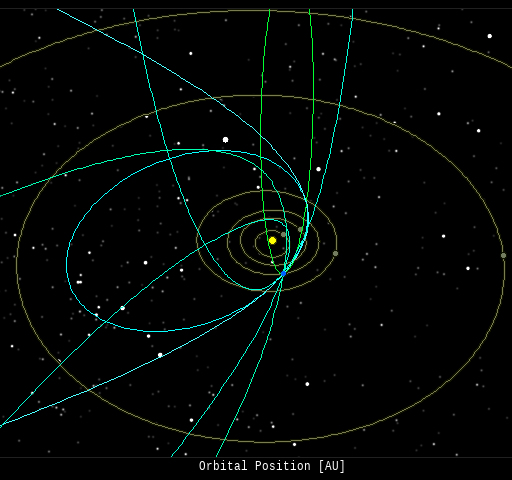 In this diagram of the inner solar system, all of the fireball orbits intersect at a single point--Earth. The orbits are color-coded by velocity, from slow (red) to fast (blue). [Larger image] [movies] Potentially Hazardous Asteroids ( PHAs) are space rocks larger than approximately 100m that can come closer to Earth than 0.05 AU. None of the known PHAs is on a collision course with our planet, although astronomers are finding new ones all the time. On July 5, 2022 there were 2279 potentially hazardous asteroids.
 | Recent & Upcoming Earth-asteroid encounters: | Asteroid | Date(UT) | Miss Distance | Velocity (km/s) | Diameter (m) | | 2022 MJ3 | 2022-Jul-01 | 0.4 LD | 8.8 | 4 | | 2022 MB3 | 2022-Jul-01 | 2 LD | 13 | 16 | | 2022 MS | 2022-Jul-01 | 8.3 LD | 6 | 27 | | 2022 MF | 2022-Jul-02 | 14.8 LD | 12.1 | 43 | | 2022 MB1 | 2022-Jul-02 | 19.1 LD | 6.3 | 17 | | 2022 JE1 | 2022-Jul-03 | 8.6 LD | 5.6 | 74 | | 2022 MY | 2022-Jul-05 | 13 LD | 7.2 | 26 | | 2021 EL4 | 2022-Jul-05 | 19.9 LD | 9.5 | 25 | | 2022 NE | 2022-Jul-06 | 0.4 LD | 10.7 | 6 | | 2022 NF | 2022-Jul-07 | 0.2 LD | 11.4 | 7 | | 2019 NW5 | 2022-Jul-10 | 14.9 LD | 16 | 62 | | 2015 OQ21 | 2022-Jul-12 | 18.3 LD | 6.6 | 9 | | 2022 NC | 2022-Jul-14 | 7.6 LD | 7.5 | 33 | | 2022 LR1 | 2022-Jul-16 | 9.3 LD | 4.7 | 42 | | 2022 KY4 | 2022-Jul-17 | 15.9 LD | 7.6 | 91 | | 2021 OT | 2022-Jul-17 | 16.5 LD | 11.2 | 20 | | 349068 | 2022-Jul-19 | 17.6 LD | 22.9 | 756 | | 2017 RX2 | 2022-Jul-24 | 17.2 LD | 14.2 | 17 | | 2022 ML3 | 2022-Jul-26 | 7.6 LD | 1.5 | 14 | | 2016 CZ31 | 2022-Jul-29 | 7 LD | 15.6 | 129 | | 531944 | 2022-Jul-30 | 18.2 LD | 5.9 | 192 | | 2020 PP1 | 2022-Aug-01 | 13.1 LD | 3.7 | 17 | | 2020 PN1 | 2022-Aug-03 | 9.7 LD | 4.6 | 29 | | 2015 FF | 2022-Aug-12 | 11.2 LD | 9.2 | 17 | | 2019 AV13 | 2022-Aug-22 | 19.1 LD | 8.8 | 135 | | 2020 QW3 | 2022-Aug-22 | 14.1 LD | 18.1 | 30 | | 2015 QH3 | 2022-Aug-22 | 5.6 LD | 7 | 14 | | 2017 BU | 2022-Aug-29 | 15.8 LD | 7 | 32 | | 2021 CQ5 | 2022-Sep-01 | 8.7 LD | 13.5 | 7 | Notes: LD means "Lunar Distance." 1 LD = 384,401 km, the distance between Earth and the Moon. 1 LD also equals 0.00256 AU. MAG is the visual magnitude of the asteroid on the date of closest approach. | | Cosmic Rays in the Atmosphere | SPACE WEATHER BALLOON DATA: Almost once a week, Spaceweather.com and the students of Earth to Sky Calculus fly space weather balloons to the stratosphere over California. These balloons are equipped with sensors that detect secondary cosmic rays, a form of radiation from space that can penetrate all the way down to Earth's surface. Our monitoring program has been underway without interruption for 7 years, resulting in a unique dataset of in situ atmospheric measurements. Latest results (Nov. 2021): Our balloons have just measured a sudden drop in atmospheric radiation. It happened during the strong geomagnetic storms of Nov. 3-4, 2021. Here are the data: 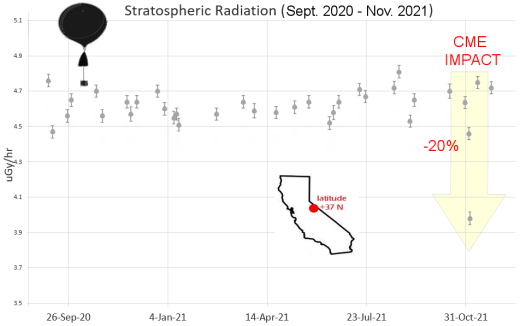
This is called a "Forbush decrease," named after American physicist Scott Forbush who studied cosmic rays in the early 20th century. It happens when a CME from the sun sweeps past Earth and literally pushes cosmic rays away from our planet. Radiation from deep space that would normally pepper Earth's upper atmosphere is briefly wiped out. We have measured Forbush decreases before. For example, here's one from Sept. 2014. The Forbush Decrease of Nov. 3-4, 2021, was the deepest in the history of our 7-year atmospheric monitoring program. Radiation levels in the stratosphere over California dropped nearly 20%, more than doubling the previous record from our dataset. En route to the stratosphere, our sensors also pass through aviation altitudes, so we can sample radiation where planes fly. This plot shows how the Forbush decrease was restricted to the stratosphere; it did not affect lower levels of the atmosphere: 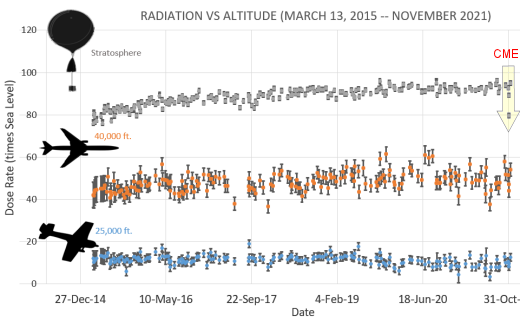
The dose rates shown above are expressed as multiples of sea level. For instance, we see that boarding a plane that flies at 25,000 feet exposes passengers to dose rates ~10x higher than sea level. At 40,000 feet, the multiplier is closer to 50x. The higher you fly, the more radiation you will absorb. .Who cares? Cosmic rays are a surprisingly "down to Earth" form of space weather. They can seed clouds, trigger lightning, and penetrate commercial airplanes. According to a study from the Harvard T.H. Chan school of public health, crews of aircraft have higher rates of cancer than the general population. The researchers listed cosmic rays, irregular sleep habits, and chemical contaminants as leading risk factors. Somewhat more controversial studies (#1, #2, #3, #4) link cosmic rays with cardiac arrhythmias and sudden cardiac death. .Technical notes: The radiation sensors onboard our helium balloons detect X-rays and gamma-rays in the energy range 10 keV to 20 MeV. These energies span the range of medical X-ray machines and airport security scanners. Data points in the first graph ("Stratospheric Radiation") correspond to the peak of the Regener-Pfotzer maximum, which lies about 67,000 feet above central California. When cosmic rays crash into Earth's atmosphere, they produce a spray of secondary particles that is most intense at the entrance to the stratosphere. Physicists Eric Regener and Georg Pfotzer discovered the maximum using balloons in the 1930s and it is what we are measuring today. | | The official U.S. government space weather bureau | | | The first place to look for information about sundogs, pillars, rainbows and related phenomena. | | | Researchers call it a "Hubble for the sun." SDO is the most advanced solar observatory ever. | | | 3D views of the sun from NASA's Solar and Terrestrial Relations Observatory | | | Realtime and archival images of the Sun from SOHO. | | | information about sunspots based on the latest NOAA/USAF Active Region Summary | | | from the NOAA Space Environment Center | | | fun to read, but should be taken with a grain of salt! Forecasts looking ahead more than a few days are often wrong. | | | from the NOAA Space Environment Center | | | the underlying science of space weather |  | BestCSGOGambling is the best site for everything related to CSGO gambling on the web |  | To find reviews of new online casino sites in the UK try The Casino DB where there are hundreds of online casino reviews complete with bonuses and ratings. Alternatively, Online-Casinos.xyz is another massive directory of online casinos listing sites for the UK and Worldwide. Casinos that offer Rupees for bonuses are very generous to Indian players. Find the best online casinos in India at AllCasinos.in Looking for a new online casino? Try Casimpo the new site dedicated to making online casino simple, or check out the new Avenger Slots Casino and Ace Online Casino with over 500 online slots and casino games. |  | One of the most popular casino games is the Book Of Dead Slot based on ancient Egyptian text, you can find all the casinos with spins at bookofdeadslotsites.com. |  | When looking for casinos to play online when the weather is bad, you can try casino online trucchi for Italian games. If you are not from Finland you can try the Swedish page Svenska casino online to find suitable games, check out svenskacasinoonline.net. Always check your local laws before playing with real money. |  | Looking for sports betting companies not registered on GamStop? CasinoGap has presented a list of sites not on GamStop available for UK players. Check and bet online! Would you like to bet at sites not using GamStop? Look at a list of NonStopCasino sites for online betting that aren't on GamStop. Top-rated bookmakers ever! | | | These links help Spaceweather.com stay online. Thank you to our supporters! | | | | | | | | |  | |  |   | ©2021 Spaceweather.com. All rights reserved. This site is penned daily by Dr. Tony Phillips. | |

